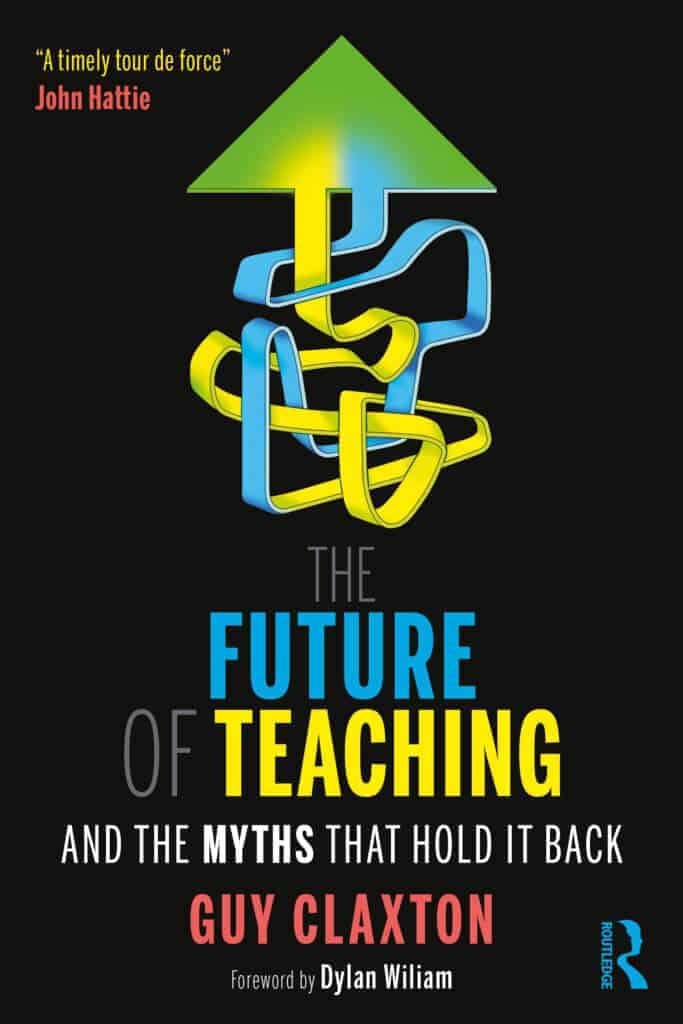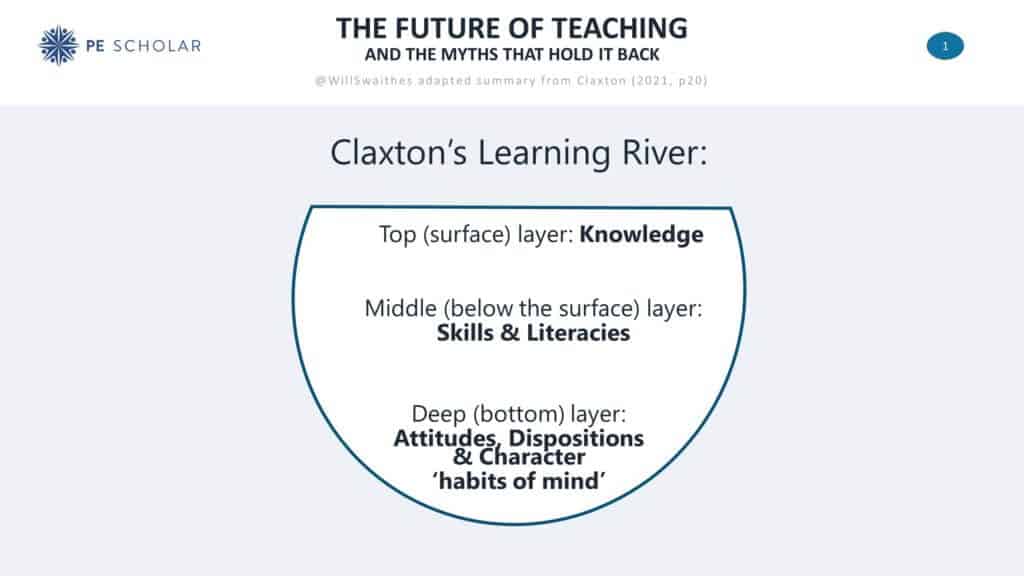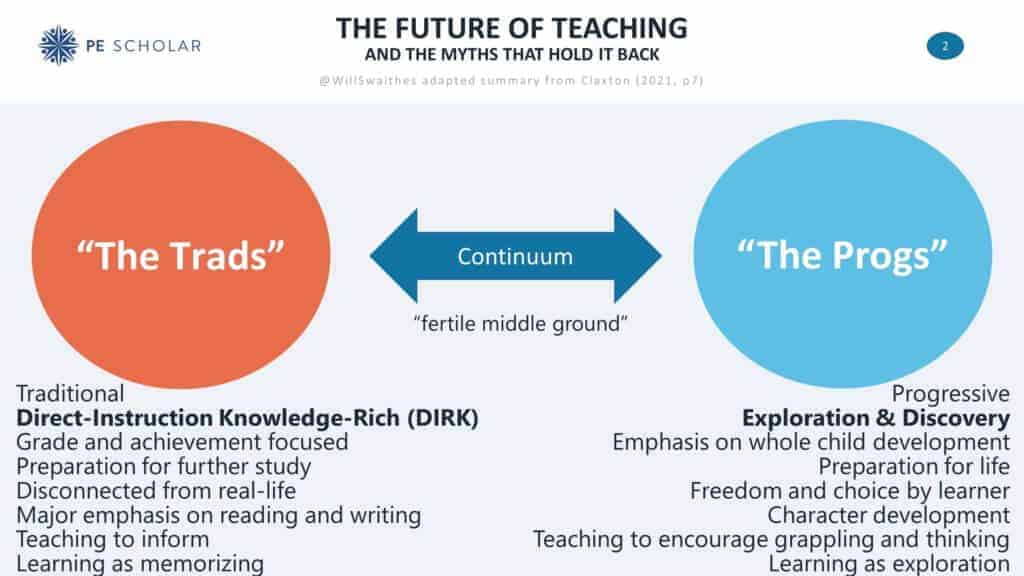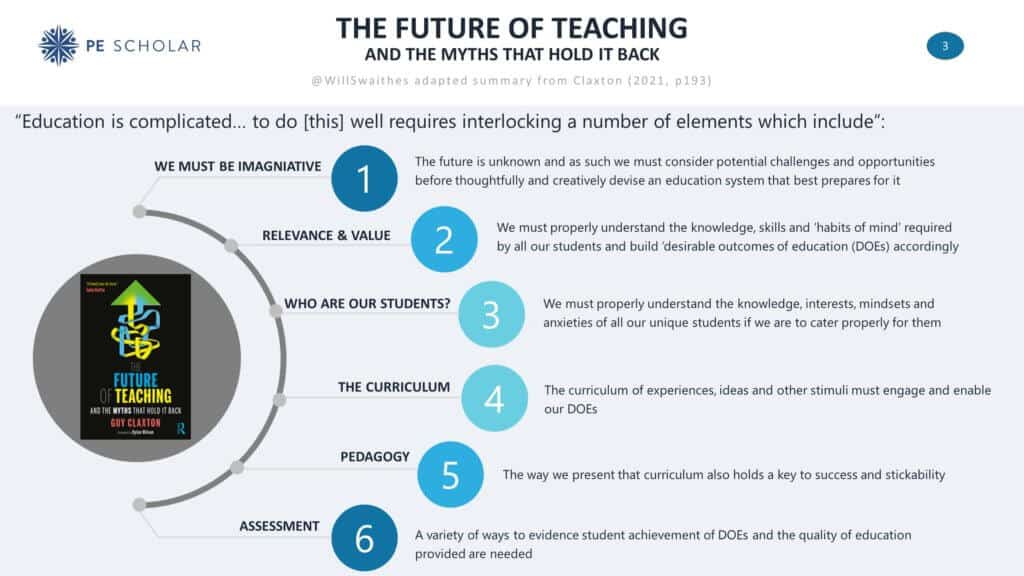
Introduction
For well over 15 years, I have followed and enjoyed Guy Claxton’s work. If you have not yet come across him but are inspired by the work of the late Sir Ken Robinson on ‘Changing Education Paradigms’ or Sir Anthony Seldon in ‘the Fourth Education Revolution’, then you will certainly enjoy this latest book. If, like me, you appreciated his work on ‘Building Learning Power’ or connected with the messaging in ‘Intelligence in the Flesh’ then you will love ‘The Future of Teaching And The Myths That Hold It Back’. Yet another classic published by Routledge in 2021.
If your mind (or worse your teaching behaviours) have been guilty of getting swept along within the echo chamber of (seemingly) cognitive science informed formulaic teaching approaches yet your gut (and your heart) continue to remind you that you signed up for much more than that in choosing to become a teacher then this is the book for you! Claxton meanders down his river of discovery to help us, the readers, explore what is happening in real schools and recognise what he calls the very “fertile middle ground between traditional and progressive” approaches to teaching.
Take-aways
If I absolutely had to sum up 194 great pages into just three take-aways, then here they are:
- The learning river – there are three layers that start with acquisition of knowledge on the surface, beneath that are the development of skills and deeper still is the cultivation of character. All three layers have value, not just those that are easily seen or tested.

- Trads vs progs – so called ‘traditionalists’ favour Direct Instruction Knowledge-Rich (or DIRKs as they are affectionately referred to in the text) may seem on the surface to be evidence-informed and the polar opposite of more progressive (hippy) approaches to teaching that consider wellbeing, guided discovery and student-centred exploration but it is possible, in fact necessary, for great teachers to find the balance that exists within and between these extremes.

- Teaching is complex – “teaching for the future – it must be sophisticated, flexible and focused” to enable the next generation to thrive in the 21st century that remains largely unknown. Perhaps these six interlocking elements summarised on page 193 help conceptualise the picture of what is needed?

However, I highly recommend investing the time, energy and opportunity to seek out your own learnings because, as clarified for me within the book, we all take a different starting point and socio-cultural references into any experience and, consequently, will take different points from it.
Chapter by chapter
1 – Punch and Judy
Exploring the battleground of progressive/ child-centred/ holistic education versus more traditional/ Conservative/ Knowledge focused approaches. Is learning about memorising facts on exploring ideas?
2 – Values
Investigating ‘the river of learning’ to understand it is not a simple “conflict between teaching knowledge and teaching mental skill” (p19), understanding ‘habits of mind’ and the importance of ‘the Goldilocks zone’ when getting students in learning mode. What do you value most as a teacher? What about as a parent, an employer, a student or any human for that matter?
3 – Knowledge
Recognising that there are many forms of knowledge: rote; factual; maxims (i.e. rules of thumb); expertise (tacit, implicit or procedural); memories and impressions; feelings, emotions and intuitions. Appreciating that turning knowledge into understanding requires a connection with existing knowledge and a complex process that considers “personal histories and current concerns”. What do you know about knowledge?
4 – Thinking
The importance of defining key terms, unpicking what we mean by thinking and different types of information as well as the idea of schools as “cognitive apprenticeships” (p58). Can (and should) generic or thinking skills be explicitly taught?
5 – Learning (and learning to learn)
Discussing how learning is about far more than that which can be assessed via examinations – people learn facts, but they also learn: impressions; patterns; distinctions; routines; skills and techniques; navigation; opinions; theories and opinions. Perhaps the bigger question is why people learn and curiosity certainly features high on the list of motivators whilst flow often leads to significant progress. This chapter also goes on to explore how people learn with a list that includes but is not limited to practice. To develop ‘habits of mind’ it is recognised that “these attributes grow in strength, complexity and breadth of application over time”. The work of David Ausubel suggests “the most important single factor influencing learning is what the learner already knows” (p90). Do you do enough to consider what each of your students already understands (or misunderstands) before planning your teaching?
6 – Memory: the ‘architecture ‘of the mind
The idea of the brain as like a computer, with a limited working memory (WM) akin to the RAM on your laptop and limitless long-term memory (LTM) storage capabilities similar to a hard drive is seriously challenged and with that the implications for cognitive load theory, chunking, information processing and more. Do you have too simplistic a view of how the brain functions and the idea of intelligence?
7 – Teaching
What matters most and can we really teach thinking? David Perkins makes six research-based suggestions on how we teach for understanding and these are explored fully from “mak[ing] learning a long-term, thinking -centred process” to “providing rich on-going assessment” and “teach[ing] for transfer” with a focus on “hard parts” if you want to have impact. Page 143 makes a really poignant point that “pressurising teachers to ‘get results’ can be counterproductive if it leads them t adopt controlling teaching strategies and create an anxious ethos that leads students, in turn, to adopt less thoughtful and flexible approaches to their learning.” Are you under too much pressure to secure better results to allow a focus on creating better humans?
8 – Reality – getting out more
Some lovely examples of great practice that is working in real schools is shared to include an exploration of Michaela Community School which is about much more than didactic teaching and rote learning. Do you have a ‘no excuses’ culture when it comes to standards and expectations?
9 – Research – but what kind?
Classrooms are complicated! The double blind randomised control trial (DBRCT) may be the gold standard of research in a clinical setting where just one outcome is being sought but the craft of preparing our next generation for their future is not as simple as cause-and-effect or intention-implementation-impact and consequently should we be looking beyond quantitative data and control groups to inform future practice in education?
10 – The future of teaching
Social science research also has a lot to offer if we are to truly hunt down best practice. “DIRK people oversimplify and misconstrue education in general, and teaching in particular” and this chapter identifies, exposes, and then concludes by suggesting a way forward from this. What are you doing to future-proof teaching to be more “sophisticated, flexible, and focused”? How can we better service our students to “naturally think critically, creatively and collectively about the world in which they find themselves”?
For any of you left wanting more, the book also features a helpful list of further reading to understand more from research and scholarship that should be featuring in your next INSET day.
Wrap up
Hopefully that has wet your whistle and if you want to excel as a (physical) educator and remain up to date with a range of perspectives around your why, how and what of teaching then I couldn’t recommend this book highly enough… dive in, and possibly out of your school’s current echo chamber.
Access other books we have reviewed via the following links:


[…] Book Club Blog: The Future of Teaching and The Myths That Hold It Back by Guy Claxton […]